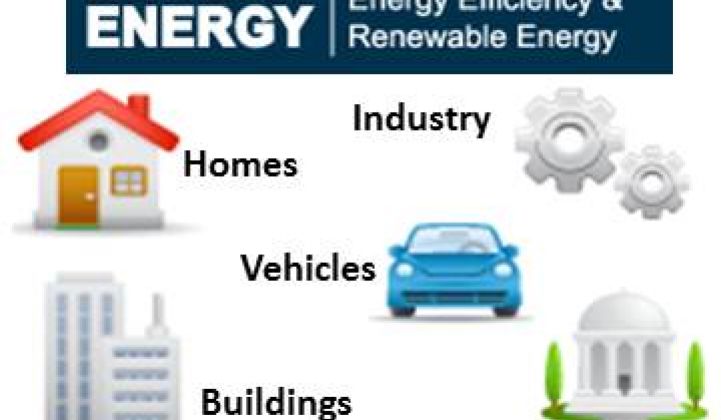Distributed renewable energy pays for itself, but Johnson Controls has a way to pay for it faster.
Johnson Controls was already a leader in Energy Savings Performance Contracting (ESPC), or energy efficiency retrofits, when the company's “customers said, ‘We want to do all that efficiency work but we also want to do renewables,’” explained Jesse Stowell, a Johnson Controls Project Development Consultant specializing in the “bundling” of wind energy and energy efficiency retrofits.
“I had seen how challenging it was to do standalone wind projects,” said Stowell, who came to Johnson Controls from the small wind business where the payback period can be protracted enough to discourage small and community consumers.
Johnson Controls is one of “10 or so household-name companies,” Stowell said, including multinational giants like Siemens and Honeywell, that have grown ESPC businesses during the last three decades. In response to its customers’ interest in renewables to go with retrofits, Johnson Controls was looking for a wind guy. Stowell saw ESPC as a way to beat the obstacles facing small wind.
“Once I pulled back the hood,” Stowell said, “I discovered that some of these efficiency measures have very short paybacks. When you’re doing 10, 12, 15 efficiency retrofits on a single project, quicker payback items subsidize others,” he explained. “You can include some things because others make the whole bundle perform.”
Stowell oversees Johnson Controls' projects that include wind. Others of the company’s 700+ engineers specialize in bundles that include photovoltaic solar, solar hot water systems, anaerobic biogas production systems, biomass-fired boilers, or geothermal heat exchange systems.
“Working with Fort Buchanan in Puerto Rico,” Stowell recalled, discussing a comprehensive efficiency retrofit for the U.S. Army where bundling was essential, “the wind energy piece couldn’t quite stand on its own” because of the need for special hurricane protections for the turbines. Financed on its own, the payback was too long. “But financed within the bundle,” he said, “the overall payback was well within the federal limit.”
Lighting and building automation significantly reduce the payback period, Stowell said. “Putting in LEDs, it’s under six years to payback,” adding, “for building automation, one of Johnson Controls’ specialties, payback can take from two to eight years, and there are all kinds of neat things you can do.”
Windows “almost never pay for themselves,” Stowell added, except with a “deeper retrofit where you take on more and the interdependency of all the systems, together, creates greater savings.”
“Wind has the advantage of being one of the most, or the most, cost-effective renewable technology when it’s on a good site,” Stowell said. “So it often doesn’t need as much help from the bundle as other renewables.” And, he said, “It’s also very appealing for customers, because after they do all this efficiency work, which is essentially invisible to the untrained eye, they can put up this wind turbine. It’s a big statement: the bow you tie on your efficiency work.”
It is, Stowell noted, “a completely different market than big wind projects that are highly dependent on federal tax incentives like the PTC [production tax credit] and the the ITC [investment tax credit]. The vast majority of the people who do ESPC are non-commercial, non-taxable entities: municipalities, schools, higher ed, federal, state and local governments,” Stowell said. “It’s totally decoupled from that roller coaster ride that the rest of the industry struggles with.”
“If you tell a private sector guy that he’s got a 12-year payback, he’s usually not too interested. But if you tell a municipality there’s a 12-year payback and it’s cash-flow neutral or cash-flow positive, they’re quite interested.”
Wind, Stowell said, is a low-risk, high-certainty piece of the typical Johnson Controls retrofit. Performance is guaranteed, measurable and verifiable, and installation includes a web-based dashboard that verifies the turbine’s output. “They therefore know they’re going to have a machine that operates as specified.”
The 12-year payback will eventually improve, Stowell said, “when electricity rates go up and low wind speed technology gets better.”
Stowell said he pushes “toward bigger machines, because you’re going to get a lower cost of energy,” but there are “influencing factors that may keep you from the largest machine” such as “building energy usage, net metering laws, wind resource, regional rate of electricity, local ordinances and height limitations, FAA regulations sometimes, as well as the pure size of the bundle, if it is going to need to be carried by the bundle.”
Stowell takes a conservative attitude toward the type of turbine he recommends. “We put long-term guarantees on these machines,” he said. “I look for turbines with a proven track record, a company that has fielded a lot of units and has a lot of run-time, turbines that have certification from a reputable third-party agency to an international standard. That weeds out most of the questionable technology,” such as vertical axis turbines.
A retrofit is designed in “a workshop, collaborative environment,” Stowell said. It begins with “what’s there, existing conditions and existing equipment. In some places, it’s a no-brainer to replace the boiler, but in others, it’s a very long payback and doesn’t make sense. Some places have a good wind resource and other places don’t.” For each “project-specific” undertaking, Stowell said, “We initially look at a larger swath of measures and whittle that down to the most compelling ones to make the project as financially successful as possible.”



